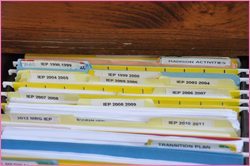 This column was originally published as part of my “Tuesdays with Madison” series at AutismAfter16.com.
This column was originally published as part of my “Tuesdays with Madison” series at AutismAfter16.com.
Tomorrow is the day. I hope I’m ready for it. Nine of us will gather around the table and for one last time make a set of goals for Madison.
It is the day of her last IEP.
I understand there will be one more “close-out” session as she transitions into her adult programs. But this is the last time this group with this purpose will gather in support of my Madison.
Soon she will be 21, so her IEP (Individual Educational Plan) will become her ISP (Individual Service Plan), I’m told, and different folks with different goals will sit with me next year. I wonder how much it will change.
But first, there is some paperwork to attend to.
“Fill this out and bring it to the meeting,” a services coordinator representative told me. “Madison will need to sign it.”
I swallowed hard at the kind voice, knowing she had no idea the nerve she hit. Madison can’t sign her name. Madison can’t write. Madison can’t read, either.
“Oh, so she’s illiterate,” one government employee had clarified to me in one of the application processes.
“Well, I’d never thought of it that way,” I said to that cold voice. “But I guess she is.”
But it is not for lack of trying.
We caught her delay early, at nine months, and immediately started services. Now, I realize that they were probably not the correct services for autism, but that was all we had at the time.
We had in-home speech therapy, occupational therapy, and then specialized toddler programs, both group and individual. Then the IEPs began—14 years of them—documenting her progress and changing needs as she moved from school to school in search of the appropriate program to meet her needs.
The faces changed around that IEP table, but not their focus. Granted, we had a few disagreements along the way. But I found if I kept the discussions Madison-focused many of those obstacles were softened as we, together, tried to set goals that would allow her to receive an education with the abilities that she has.
To address her writing skills, we were creative. We tried tracing, chunky pencils, rubber bands that wrapped a pencil to her fingers, even hand-over-hand training. But she still could not sign her name.
Anticipating the drama, I called the school’s director and told her Madison would need to sign her name to some documents that were going to be at the IEP meeting.
“I don’t think she can sign anything, can she? Will she have to use her name stamp? Is that acceptable?” I rattled on.
“No worries,” the kind and confident voice assured me. “Whatever she signs is her mark. It is enough.”
As I hung up the phone, my eyes welled at her words. I opened the Madison file drawer and looked back over the 14 years of IEPs.
We tried. We tried hard. And, it is enough.
Madison is happy, healthy, and knows how to communicate most of her needs. She’s knows her colors, shapes, numbers and can sort, count, and follow simple instructions. And, thankfully, she’s learned how to ask for help.
She may not be able to sign her name but she can sing a song. She can dance. And she can tell you that she loves you.
It is enough.
Follow Me!